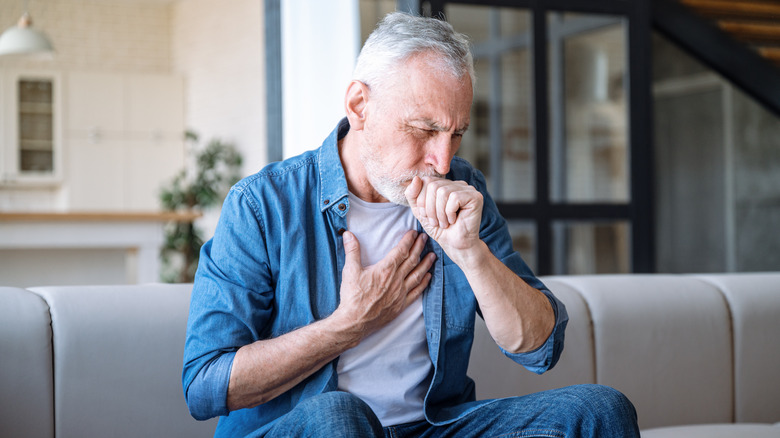The Leading Cause Of Cancer Deaths May Surprise You
Many cancer advocacy groups host public awareness campaigns educating people about how to prevent different types of cancer. You'll most likely recognize the pink ribbon that reminds you of the importance of breast cancer screenings. You'll probably also think twice before heading out the door without sunscreen due to the awareness campaigns focused on skin cancer. And thanks to Sharon Osbourne sharing about her battle with colon cancer, you're probably also aware of the importance of colonoscopies and at-home screening tests.
Given the high visibility of these campaigns, you might believe that one of these types of cancer would be the leading cause of cancer deaths each year. However, while breast cancer is the most prevalent cancer diagnosis among women and prostate cancer is the most prevalent among men, the National Cancer Institute says that lung cancer is the most common type of cancer death in the United States. Among the estimated 611,000 people who will die of cancer in 2024, lung cancer will account for 20% of those deaths. Colorectal cancer and pancreatic cancer deaths are the second and third leading causes of cancer deaths.
Why do more people die of lung cancer?
Even though breast cancer and prostate cancer are more prevalent among women and men respectively, they both have more than a 90% five-year relative survival rate. Lung cancer is the third highest cancer diagnosis behind breast cancer and prostate cancer, but it has a 26.7% five-year relative survival rate, according to the National Cancer Institute.
Although early detection of lung cancer might improve the rate of survival, the World Health Organization (WHO) says that people often get diagnosed with lung cancer when the cancer has advanced. That makes the disease harder to treat because it's spread through the body and can resist chemotherapy.
Detecting lung cancer early is difficult because symptoms don't often show up in earlier stages, according to SERO. People might experience early signs of lung cancer such as a persistent cough, worsening chest pain, loss of appetite or weight, or wheezing. When lung cancer metastasizes, people could have pain in their bones, headaches, seizures, yellowing of the skin, or swelling of lymph nodes. Once these symptoms do appear, the cancer is in its more advanced stages.
Causes and risk factors of lung cancer
About 85% of lung cancer cases worldwide are due to smoking tobacco, according to the WHO. In fact, your life expectancy is three years lower if you live in one of the 12 states that have a high prevalence of smoking. Even though smoking tobacco increases your risk of lung cancer, it's still unclear if smoking marijuana is also linked. However, the American Lung Association says the tar found in marijuana cigarettes is the same cancer-causing substance found in tobacco.
People who don't smoke but are exposed to second-hand smoke or chemicals such as asbestos or radon or who have hereditary cancer syndromes could also develop lung cancer. Outdoor air pollution in cities slightly increases your risk of lung cancer as well.
Quitting smoking is one controllable factor to reduce your risk of lung cancer. The sooner you quit, the better, according to a 2020 study in the Annals of the American Thoracic Society. After one year of quitting smoking, you'll reduce your risk of lung cancer by 19% compared to if you were a habitual smoker. You'll lower your risk by 43% after your fifth year of quitting tobacco, and your risk decreases by 80% 20 years after you quit smoking.
If you choose to smoke, taking beta-carotene supplements might increase your risk of lung cancer. Even though beta-carotene has many health benefits, a 2019 study in Nicotine & Tobacco Research found that smokers who took beta-carotene supplements increased their risk of lung cancer by 31%.


